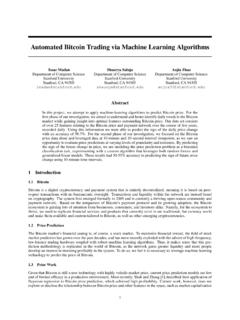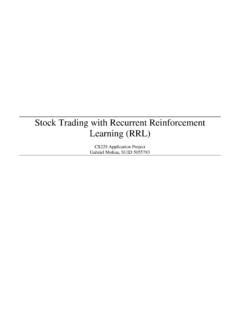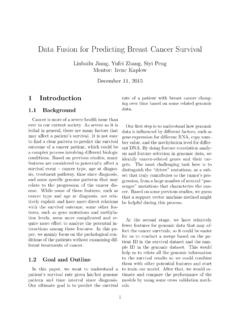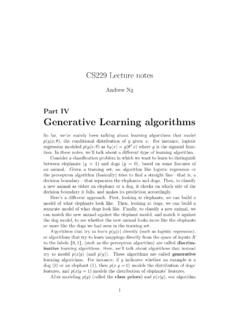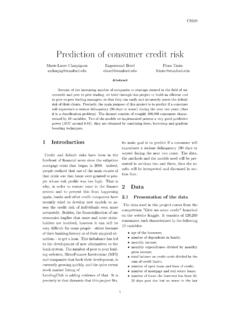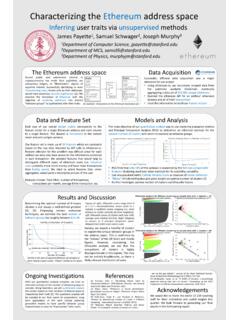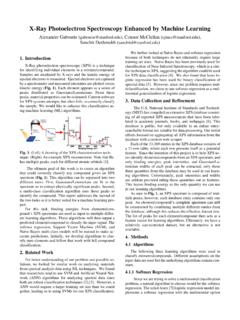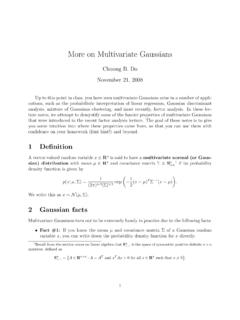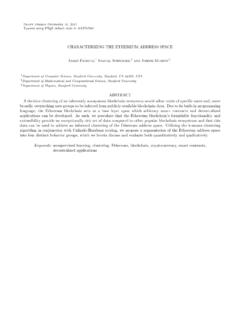Transcription of STOCK OPTION PRICE PREDICTION - Stanford University
1 STOCK OPTION PRICE PREDICTIONABRAHAM main motivation for this project is to develop a better STOCK options priceprediction system , that investors as well as speculators can use to maximize research papers have been written to help investors predict STOCK PRICE aswell as pick portfolio to maximize their returns. However, the there isn t muchpapers that exist for maximizing returns on STOCK options or predicting stockoption at NIPS and ICML, I saw there is a papers for better comping up with abetter STOCK PRICE predicting, based on the given conditions; however, it assumethat you already knowing the STOCK prices for the goal of this project is develop a system that will help predict the percentprice change for a STOCK and use that to predict the percent PRICE change of theunderlying OPTION for the STOCK . This can also be used in order to help predictbest OPTION portfolio to help or develop an options trading strategy to OverviewStock options are investment instruments that are mostly used in order tominimize risk for a STOCK trader.
2 An OPTION contract comes in two types:(1) 1 Call options : allows the owner to buy 100 shares of the underlyingequity at the PRICE the OPTION specifics.(2) 1 Put options : allows the owner to sell 100 share of the underlying equityat the PRICE the OPTION have expiration date, as such the PRICE of an OPTION decreases with eachpassing day until they become worthless if they are out of the money1, or equalto the difference between the PRICE of the equity and OPTION contract if it s in themoney2. options come in two flavors - American and European - the difference isthat American options can be exercised at any time while European options canonly be exercised at expiration. for the purpose of the project we will think of allthe options as European : December 14, than the equity PRICE for call options , and lower than the equity PRICE for put options2lower than the PRICE of the OPTION for call options , higher than the PRICE of the equity for putoptions12 ABRAHAM ADAMSome speculators and traders choose to use options in order to maximize risk andreward rather than minimize risk.
3 The reason that options as risky is that theyare constantly losing value and their PRICE is affected by volatility sense they areintended to counter volatility, if the STOCK doesn t move the expected directionfast enough, the owner of the OPTION can lose more of the value of the OPTION ontime decay and SetsFor the purpose of this project, 2 stocks where chosen as the examples for thegeneral STOCK market. Those two are:(1) Intel which is a DOW 30 component, it represent a large cooperation withlow volatility.(2) Nvidia Which is a NASDAQ component, it represents a smaller companywith high the two stocks chosen, STOCK volume , open PRICE , closing PRICE , volume, highand lower were obtained from yahoo3from the time they went public toDecember 7th, 2012. This data was used to compute technical indicators thathelped us predict STOCK prices for future data were also obtained for both stocks from ivolatility4for 6 month ofdata June 7th, 2012 to December 7th, 2012 - that is 126 trading day, and everyday has in the range of 250 different OPTION - different strike PRICE and expirationdates for each call and put.
4 The data that was obtained contains: OPTION type,strike PRICE , mean OPTION PRICE , volume,open interest,delta,vega,gamma,theta, and OPTION order to predict the change in PRICE for a STOCK ,Technical indicators are used to help point the direction we expect the STOCK tomove. below is a small description of the 10 technical indicators that are (1) Stochastic Oscillator: Location of the current PRICE relative past prices.(2) Relative Strength Index: How strong is the STOCK moving in it s direction.(3) Chaikin Money Flow: Measures if money is flowing in or out of the STOCK .(4) Simple Moving Average: Average over the STOCK prices for a given period.(5) Exponential Moving Average: Gives higher value to later values.(6) MACD: Difference between two EMA s(7) Williams %R: determine if STOCK overbought over oversold.(8) Ultimate Oscillator: combines moving averages from different periods.(9) Mass Index: Indicates Reversal based on different from high and low.
5 (10) volatility: Standard deviation of a STOCK over a is a total of 20 features because different parameters are used in SMA andEMA to capture more of the : +Historical+Prices,Intel: +Historical+Prices4 of each of those parameters is in the following section6for exact details about how to calculate each of those indicators go to the in the referencesSTOCK OPTION PRICE looking at an OPTION it is important tounderstand how it s PRICE change depending on the underlying equity as well asdue to time decay and volatility. Those factors are captured by the greeks foreach : OptionP rice EquityP rice= change in OPTION priced based on underlying equityGamma: 2 OptionP rice 2 EquityP rice= sensitivity of delta to underlying equityVega: OptionP rice EquityV olatility= change in OPTION priced based on volatility of equityTheta: OptionP rice T imetomaturity= amount lost from OPTION value for every passing dayrho: OptionP rice riskfreeinterest= change in OPTION PRICE based on change of riskless ProcessingFor stocks , instead of using the STOCK PRICE as the the expected output for ouralgorithm, the change in PRICE with respect to the day before is used EMA and SMA values that we got are subtracted from the STOCK PRICE anddivided by the STOCK PRICE so we only have to see the difference of the averageswith respect to the STOCK .
6 That is needed because the expected output is theday s changeThe technical indicators for the STOCK were normalized with respect to the meanand the variance. This was needed because some of the data are stochastic data,so they only oscillate between a certain range, while other are free extra features for each OPTION , the number of days till expiration, and volumeof the underlying STOCK was added. For performance reasons7the optionsparameters set is filtered to contain only the options with strike PRICE within 5dollars of current PRICE . After filtering we have about 6,000 data points for calculated for the options based on the predicted STOCK pricesand it was used in the for STOCK PRICE PredictionThe first step for future options PRICE change is being able to predict the pricechange of the underlying STOCK , with some reasonable correctness. In order topredict the PRICE change of the future, the technical indicators pointed above first an attempt was done to generate regression lines using svm; however,after realizing that the model observed gives over 95% error on the training set, aswitch was done to try Support Vector Regression epsilon and nu with Gaussian9kernel which provided much better results.
7 The same data sets were with LMSL inear Regression to see if the results are improved on the training any learning algorithm on the full set takes over 30 minutes8 function that is chosen is radial basis function4 ABRAHAM for OPTION PRICE PredictionBefore testing predicted the PRICE of options based on the prices predicted, optionprices where predicted based on the true PRICE . That showed high enough results,so a swap was made to the predicted STOCK PRICE with confidence in the optionprediction predicting the prices three measurement were made in order to see whathelps us get the most accurate result. First, measuring options PRICE based onprice change and the options parameters listed above. Second, measuring optionsprices based on Black-Scholes with no learning, just applying the , measurement where taking for using the result of Black-Scholes as aparameter to SVR and testing the results stated below is based on 80% of the options data going totraining set and 20% of the data going to test for OPTION PRICE PredictionCorrectness is a measurement of the number predictions that are within a certainof margin of error from the true PRICE divided by the total number of proves to be a more accurate indicator of how good is the predictionthan mean square error because the large number of options in the test C[#] denotes correctness within the #results with actual STOCK PRICE ran on the NVIDIA setSetMSEC[ ]C[ ]C[ ]
8 Training Set without Black-Scholes Set without Black-Scholes Set without Set with Black-Scholes % Set with Black-Scholes Set without Black-Scholes Set without Black-Scholes Set with Black-Scholes % % %Test Set with Black-Scholes % %From the results above it s clear that running SVR with with Black-Scholes yieldsthe best result, so when running the learning algrothem on predicted prices forNVIDIA and INTEL we will measure the expected prices using Black-Scholes SVRR esults with predicted prices for NVIDIA and INTCSTOCK OPTION PRICE PREDICTION5 SetMSEC[ ]C[ ]C[ ]Test NVIDIA for next NVIDIA for next 2 NVIDIA for 5 INTEL for next % INTEL for next 2 INTEL for next 5 % %Results for PREDICTION for NVIDIA s STOCK priceSetMSEC[ ]C[ ]C[ ]Test NVIDIA for next NVIDIA for next 2 NVIDIA for 5 % over 50% accuracy we can predict options for next day, 2 days and next 5days, if error is allowed. and nearly 75% accuracy if error is dramatically improves the correctness of SVR as well as LR, andadding the Greeks adds a slight improvement over just running Black-Scholeswith no Machine thing worth noting is that even though the correctness of the predictedoption PRICE is low, SVR attempts to make up for the difference and producedbetter results for the OPTION pricing than we had for the expected STOCK also notice that increasing the number of days we look in the future doesn tsignificantly lower the the future, it is worth putting more time into doing a better job predicting theunderlying STOCK prices.
9 The day of the week or month of the year can be addedas helpful parameters. analyzing the news may also help yield higher accuracy , aswords as Federal Reserve or War may help us predict the PRICE change @articleCC01a, author = Chang, Chih-Chung and Lin, Chih-Jen, title =LIBSVM: A library for support vector machines, journal = ACM Transactions onIntelligent Systems and Technology, volume = 2, issue = 3, year = 2011, pages =27:1 27:27, note = Software available at cjlin/libsvm@miscwebsite:stockcharts, author = Interactive Data Corp , title = TechnicalIndicators and Overlays , year = 1999-2012 , url = :technicalindicators @miscwebsite:cs229, author = Ng, Andrew , title = Machine Learning AtStanford , year = 2012 , url = @book author = Haug, Espen Gaardner , title = The Complete Guide toOption Pricing Formulas , year = 2007 , publisher = McGraw-HillProfessional
